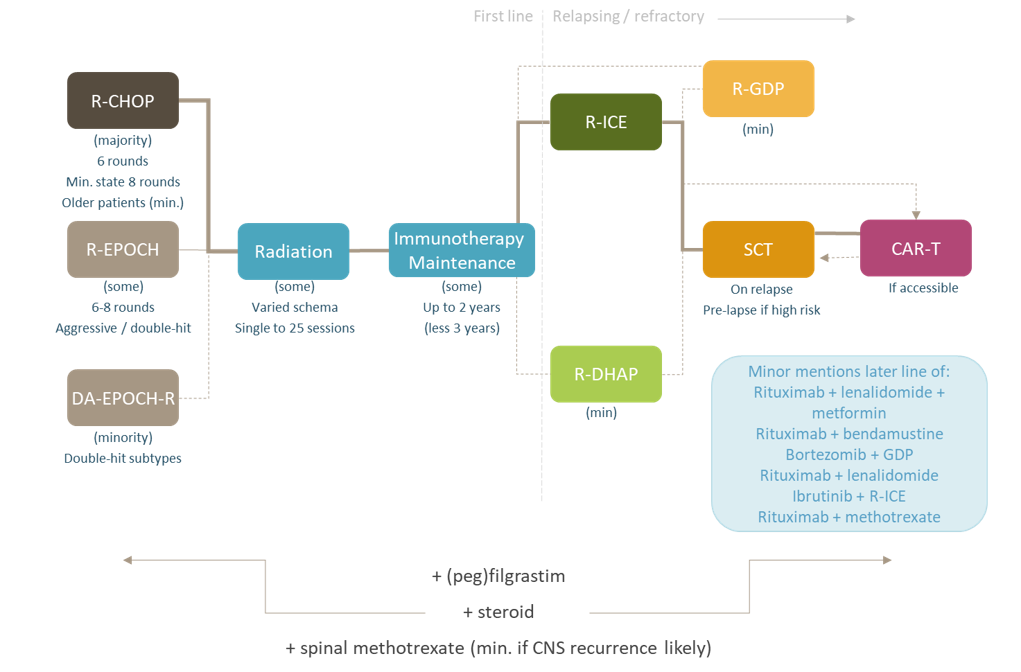The BLOG
This blog provides exclusive content for market researchers and marketing managers involved in Healthcare Marketing, prepared by APLUSA teams, and includes APLUSA important news updates.
DLBCL Case Study: Enhancing Patient Journey Research with Social Media Listening
Using the example of a recent AplusA study in Diffuse Large B-Cell Lymphoma (DLBCL), we consider combining the emotional, behavioural, and clinical dimensions of the patient journey using qualitative research methods in conjunction with social media listening.

When designing market research studies on the patient journey, we begin by examining the clinical pathway from the first symptoms, diagnosis, and relevant lines of treatment.
We research the impact of the disease on the patient’s daily life as well as recording the patient’s emotional response to the experience. The evolution of the patient's relationship with HCPs and significant others is also taken into consideration. Findings from each of these research areas are drawn together under the patient’s conceptualization of the disease which examines how they engage with the illness and the language they use to discuss it.
Drawbacks of only using one-to-one interviews
DLBCL patient journey research has traditionally been conducted using one-to-one interviews but there are drawbacks to conducting patient research using this method only:
-
Asking a set of pre-defined questions can risk shaping findings. For example, researchers may not ask any questions on a topic that was important to the patient, which could result in this information being omitted from the study’s findings and conclusions.
-
Recruiting a balanced set of patient respondents across lines of treatment for diseases such as DLBCL can be difficult, especially when recruiting patients receiving later line treatment.
-
During one-to-one interviews respondents’ comments can be influenced by what they feel would be of interest to the market researcher or pharmaceutical company, rather than express more complete thoughts and experiences.
-
Respondents are asked to recollect events that may have happened several months or years previously and as such their recall may not be entirely accurate. There is also often a lack of caregiver perspectives unless separate caregiver interviews are conducted.
Enhancing qualitative patient research with social media listening
The online discussion of DLBCL consists of over 22,000 mentions (October 2019). Of the total number of mentions on the disease, 419 came directly from patients and caregivers (mostly on forums and Instagram) and were included in this case study. We discovered that blogs, Instagram, Twitter, news, and forums are the preferred media for caregivers (59%) while Instagram is the channel used predominantly by patients (42%). For further information on these breakdowns, download the full presentation here.
Social media listening has the potential to greatly enhance market research studies, but we found that standard, algorithm-based social media listening lacked the depth required to understand the patient experience. For instance, our trials determined that there was little added value from social media listening in:
- Quantification of specific steps in the patient journey
-
Quantification of emotions
-
Sentiment analysis
A standard algorithm-based approach to social media listening tells you is what might be relevant to the patient journey and what might be occurring on an emotional level.
We concluded that standard social media listening alone is of no use when researching the patient experience in a chosen therapy area, in order to gain a broader and more in-depth picture of the patient journey.
We explored the value of conducting hands-on qualitative analysis of the social media posts using traditional methods. This approach allowed us to deep dive into all stages of the patient journey and reveal different insights than are found during one-to-one interviews.
To address the need to further understand the DLBCL patient journey (or clinical pathway), we constructed a treatment algorithm in DLBCL, corroborated by in-house quantitative patient record data.

DLBCL patient journey as revealed by enhanced social media listening research
Impact on patients’ daily life
Examining social media posts further revealed the impacts DLBCL has on the everyday lives of patients. Treatment for DLBCL is aggressive and demanding in terms of logistics and can therefore have profound impacts on the patient's daily life and mental health.
According to patient social media posts, we found it is hard to maintain normal daily activities and treatment affects patients’ sense of identity. A significant struggle is the ability to continue to work due to the number of medical appointments patients must attend, and the exhaustion they experience if they are able to continue working full-time. The posts also reveal an inability to be genuine within relationships and a feeling that patients’ can't forget about their condition nor put their fear aside. Patient and caregivers communicate emotional responses on social media as they move from diagnosis through lines of treatment.
“After a very busy weekend I went to Starbucks today to study for my NCLEX and 2 1/2 hours later I’m in bed absolutely exhausted. I pushed myself this weekend and now I literally can’t move. Not everyday is a good day and I need to listen to my body and try to slow down. It’s so hard”
Example patient post. Source: www.instagram.com
Conceptualization of the disease
Analysis of language within posts allows us to identify how patients conceptualise their experience of DLBCL and the treatment they receive. The most frequently used words and expressions are: war, fight, journey, luck, dislocation from life.
Combining Real World Patient Data with Social Media Listening
For a detail-oriented representation of the clinical pathway of DLBCL patients, it is highly insightful to combine real-world patient record data alongside qualitative social media listening capacities. Qualitative social media listening brings life to the hard-clinical facts derived from physicians’ patient records, adding a human dimension. The robust, fact-based quantitative patient record form data substantiates what patients report and gives insight into physician decision-making within a therapy area. The addition of emotional depth to the quantitative understanding of the patient pathway creates a more impactful appreciation of what life is like living with an illness.
Ultimately, bringing together two traditionally disparate worlds, the clinical and the emotional, leads to a synergistic understanding of all aspects of patient journey in a given therapy area.
This post summarizes the findings presented by our Qualitative Research Director Hannele Duval at PMRC Basel, November 2019. For more detailed insights from the study, access the full presentation via the link below.
Source: AplusA Syndicated DLBCL Study 2019

